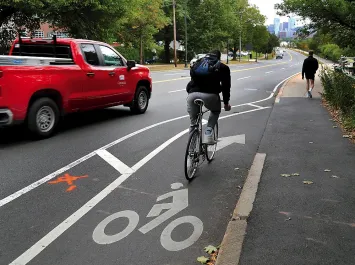Behind the Scenes: Safe Streets
Staff writer Max Krupnick reflects on how his daily commute inspired his feature.
Harvard Magazine is both a publication and a place. But our staff’s journey to 7 Ware Street, at the edge of campus, can be perilous. When I bike, my head is on a swivel, looking out for too-close cars and opening doors. When I walk, I hope that drivers will stop for me at the crosswalks. This past year in Cambridge, drivers have killed three bikers.
As I made my way to work in recent months, I wondered why America’s roads are uniquely dangerous. Why are 40,000 Americans killed on the road annually? Why—despite technological improvements—has that number stayed relatively constant for 75 years? And why have pedestrian fatalities doubled since 2009?
With these questions on my mind, I started talking to people. I attended a traffic safety conference in Boston, where Harvard-affiliated doctors, architects, and civil servants discussed the scope of the issue and the long road to improvement.
Street safety, I soon learned, is a multifaceted problem: cars, roads, laws, and urban design all contribute to deaths. To write about this topic, I had to learn about many fields. So, I spoke to a dozen experts across Harvard’s various schools, probing the roots of the problem. Donors like you enable me to spend hours talking to students, professors, and alumni—the time it takes to get a full, fair understanding of a complex challenge like this one.
I like to think of the magazine as a community publication. So even when writing about an issue like infrastructure, I place the Harvard community and its people at the center of the story. You will find personal narratives interwoven throughout this tale of systems failure.
One such narrative carries particular meaning. With the encouragement of editor John Rosenberg, I opened this story with the tragic death of John Corcoran ’84, who was killed while biking on the Charles River bike path this past fall. I was able to spend time with Corcoran’s son, Jack ’25, and share the Corcorans’ story in a separate web-exclusive report. Donors like you grant me the freedom to share important stories like the Corcorans’, extending our coverage beyond the constraints of print.
Tackling a challenge as large as making America’s 4 million miles of roadway safer for everyone is daunting. But I hope people will not be dissuaded by the scope of the problem. The path to safer roads, according to many of the experts I consulted, will come through countless small, incremental steps. Road designers can induce slower speeds. Urban planners can narrow arterials and simplify driving patterns. Local governments can improve walkability and pedestrian safety. Legislatures can strengthen enforcement. Manufacturers can restrict car size. Drivers can put down their phones. After decades of continued carnage, I hope Americans will begin to take road safety more seriously, in part with ideas developed across the University community. I am glad I could share these insights with readers, thanks to your generous help.
Read “Safe Streets”


